If you’ve ever wondered, “What are scales on a guitar?” then you’ve come to the right place. Understanding basic scales and their applications is crucial for every guitarist, regardless of their level of expertise.
Scales lay the groundwork for melody, harmony, and improvisation on the guitar. They’re a collection of notes organized in a specific pattern that create a musical framework.
This blog will equip you with the knowledge & skills to confidently explore scales on the guitar. We’ll go over the basics of the Major Scale, Minor Scales, Pentatonic Scale, Blues Scale, musical modes, and answer some commonly asked questions.

Understanding Music Scales
Definition & Purpose of Scales in Music Theory
In music, a scale is a sequence of notes arranged in ascending or descending order, typically with specific intervals between them.
The purpose of a scale is to establish a framework for creating melodies, harmonies, and chord progressions.
Scales provide a foundation for understanding and analyzing music, as well as improvising and composing within a given key or tonality.
Components of a Scale: Notes, Intervals, Scale Degrees
A scale consists of individual notes arranged in a specific order. Notes are assigned letter names (A, B, C, etc.) and can be modified by accidentals. Accidentals are things like sharps or flats (# or b)
An interval refers to the distance between two pitches, typically measured in terms of the number of steps or semitones. It describes the relationship and the pitch gap between two notes, regardless of their context within a scale or key.
A scale degree refers to the position of a specific note within a scale, typically described using numbers. The first note of a scale is referred to as the tonic or the first scale degree, while subsequent notes are assigned ascending numbers.
For example, in the C major scale, the notes C, D, E, F, G, A, and B are referred to as the first, second, third, fourth, fifth, sixth, and seventh scale degrees, respectively.
Anatomy of a Guitar Scale
Fretboard Layout & String Arrangement
To understand how scales work on the guitar, it’s crucial to familiarize yourself with the fretboard layout and guitar string letters.
The guitar consists of six strings, typically tuned to E-A-D-G-B-E. Each string represents a different pitch, with the lowest-pitched string (the thickest) at the top and the highest-pitched string (the thinnest) at the bottom.
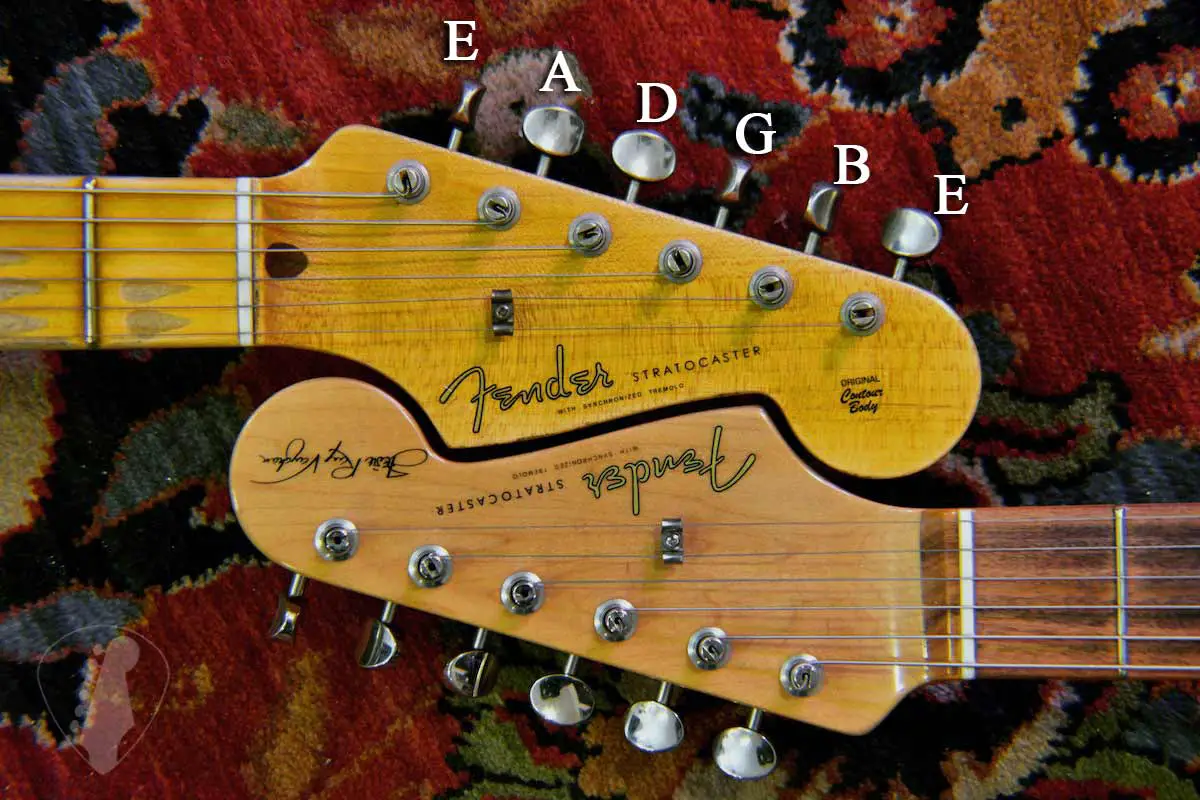
Related: The Anatomy of an Electric Guitar
Identifying Notes on the Fretboard
Knowing how to identify notes on the guitar fretboard is essential for playing scales. Each fret represents a different note, and the open strings correspond to specific pitches.
By understanding the relationship between frets and notes, you can locate any desired pitch on the guitar. Which is really helpful when applying scale patterns & finding intervals.
Intro to the Concept of Scale Patterns & Positions
A scale pattern refers to a specific sequence of intervals and steps that create a particular scale. It defines the structure and arrangement of notes within a scale, regardless of their specific position on the guitar fretboard. Scale patterns are often represented as a series of dots or numbers on a diagram, indicating which frets to play and which fingers to use.
On the other hand, a scale position refers to a specific location or position on the guitar neck where a particular scale can be played. It involves mapping out the scale pattern on a specific region of the fretboard, allowing you to play the same scale only in different positions and octaves. Each scale position utilizes a different set of frets and strings, but the pattern remains the same.
Major Scale
Definition, Structure, & Formula
In music, the major scale is a fundamental and widely used scale. It has a bright and upbeat sound that is frequently associated with happiness and positivity.
The formula for the major scale is a specific pattern of whole steps and half steps.
The major scale formula is: WWHWWWH
Major Scale Diagram
To play a major scale on the guitar, you can start with any note and follow the formula mentioned earlier.
By applying the formula and shifting it to the different scale starting positions on the fretboard, you can play major scales in different keys.
Here is a diagram of the C Major scale to help you visualize the pattern on a single string.

The Foundation of Western Music
The major scale is a fundamental component of Western music. It serves as the foundation for chords, harmonies, and melodies in a variety of genres.
Many Western musical traditions revolve around the major scale and the major keys that correspond to it.
Understanding the major scale allows you to better understand the tonalities and structures found in countless songs, making it a must-know concept for any aspiring musician.
Popular Songs That Utilize the Major Scale
The major scale is prevalent in a vast array of popular songs across various genres. Its cheerful and familiar sound can be found in countless melodies that have resonated with listeners for ages.
Songs like “Happy Birthday,” “Twinkle Twinkle Little Star,” and “Somewhere Over the Rainbow” are examples of popular tunes that utilize the major scale.
Exploring these songs and recognizing the major scale within them can enhance your understanding of its practical application in real-world music.
Minor Scale
Definition, Structure, & Formula
The minor scale is an important element in music, and it is frequently associated with a melancholy and introspective mood.
The natural minor scale is one of the primary minor scale variations. It has a unique structure because it follows a specific pattern of whole steps and half steps.
The formula for constructing a natural minor scale is: WHWWHWW
Minor Scale Diagram
To play a natural minor scale on the guitar, you can begin with any note and use the previously mentioned formula.
You can play minor scales in different keys by applying the formula and shifting it to different positions on the fretboard.
To help you visualize the pattern on a single string, here is a diagram of the C minor scale.

Variations of the Minor Scale: Harmonic Minor and Melodic Minor
Apart from the natural minor scale, there are two notable variations: the harmonic minor scale and the melodic minor scale.
The harmonic minor scale introduces a raised seventh degree, which creates a distinct and exotic sound.
The melodic minor scale, on the other hand, alters the sixth and seventh degrees when ascending, but reverts to the natural minor scale when descending.
These variations add unique flavors to the minor scale and are frequently employed in different musical contexts.
The Emotional Characteristics of the Minor Scale
In general, the minor scale is associated with feelings of melancholy, sadness, introspection, and even mystery.
Its unique interval pattern, which includes a minor third, evokes tension and longing. The emotional impact of a scale, however, is subjective and can be influenced by factors such as tempo, dynamics, and the overall musical context in which it is used.
Musicians frequently use the emotional qualities of the minor scale in their compositions to convey a wide range of moods and expressiveness.
Pentatonic Scale
Major Pentatonic Scales
The major pentatonic scale is a five-note scale that has a joyful and uplifting sound. Its formula is root note, whole step, whole step and a half, whole step, whole step.
Here’s a C Major pentatonic scale you can try out:
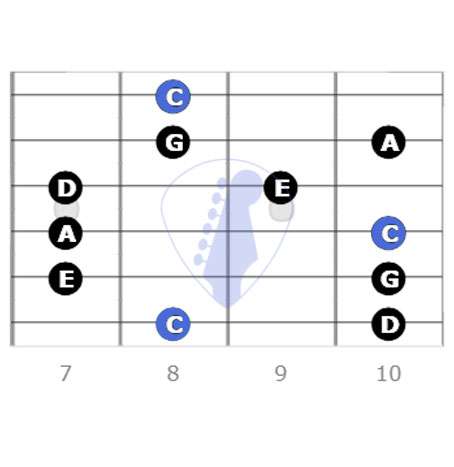
The major pentatonic scale finds extensive use in genres like rock, blues, country, and pop due to its versatility. It is perfect for creating catchy melodies, guitar solos, and improvisations.
When improvising with the major pentatonic scale, you can utilize techniques like bending, sliding, and hammer-ons/pull-offs to add expression. Exploring rhythmic variations and combining major pentatonic scales with other scales can expand your improvisational skills.
Minor Pentatonic Scales
The minor pentatonic scale is also a five-note scale with a melancholic and bluesy character. Its formula is root note, whole step and a half, whole step, whole step, whole step and a half.
Here’s what a C Minor Pentatonic Scale looks like:
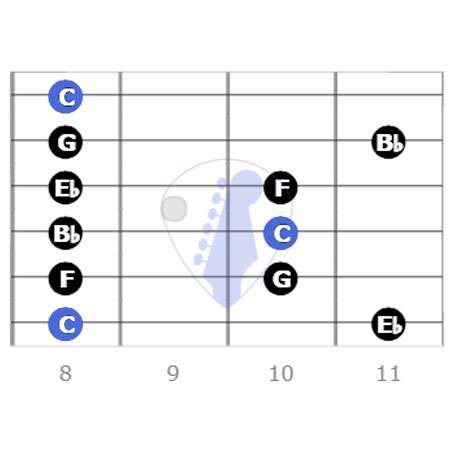
Because of its expressive and soulful nature, the minor pentatonic scale is widely used in genres such as blues, rock, jazz, and many others. It’s perfect for making emotional melodies, guitar solos, and improvisations.
Techniques like bends, slides, and hammer-ons/pull-offs can add depth and feeling when improvising with the minor pentatonic scale. Experimenting with rhythmic variations and combining minor pentatonic scales with other scales can help you broaden your improv palette.
Blues Scale
Definition, Structure, & Formula
The blues scale is a six-note scale that is widely used in blues and rock music to create a distinct and soulful sound.
It combines elements of the major and minor pentatonic scales, often featuring a “blue” note or flattened fifth.
The formula for constructing a blues scale in the key of C using whole steps (W) and half steps (H) is C – Eb – F – Gb – G – Bb – C.
Starting from the root note of C, you would go up a whole step to Eb, then another whole step to F, followed by a half step to Gb, another whole step to G, another half step to Bb, and finally back to the root note of C.
This formula represents the specific intervals between the notes in the C blues scale, giving it its characteristic bluesy sound.
Blues Scale Diagram
This is what the blues scale looks like in 2 octaves across all 6 strings. Try it out & then try to shift the same pattern across other root notes to get a feel for it.
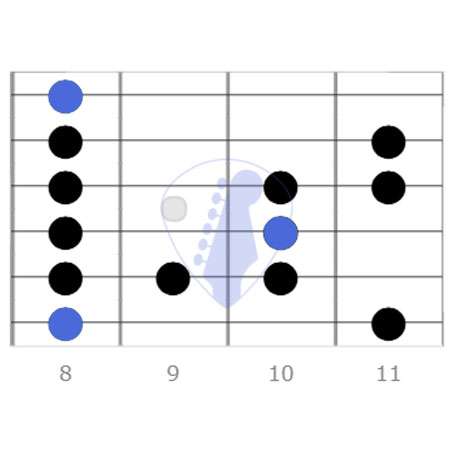
Application in Blues & Rock Music
The blues scale is a staple in blues and rock genres, lending an authentic and expressive feel to music. It is commonly used in both rhythm and lead guitar parts, allowing musicians to infuse their playing with a bluesy vibe. Many iconic blues and rock songs prominently feature the blues scale, showcasing its importance in these genres.
Adding Bluesy Flavor to Guitar Solos
When soloing, the blues scale provides a variety of expressive options. You can enhance the bluesy quality of the scale by introducing bends, slides, and expressive techniques into your playing. Experimenting with rhythmic changes, dynamics, and note selections within the blues scale will help you capture the spirit of the blues and create engaging musical moments.
Modal Scales
Overview of Modal Scales
Modal scales provide a wide range of tonal colors and musical possibilities. Each modal scale is formed from a different degree of the major scale, giving rise to distinct sounds and musical characteristics. The following are the most often used modal scales:
- Ionian (Major Scale)
- Dorian
- Phrygian
- Lydian
- Mixolydian
- Aeolian (Natural Minor Scale)
- Locrian
Unique Characteristics & Musical Applications
Each modal scale possesses its own distinct characteristics, providing a specific musical flavor. For example, the Dorian mode has a minor feel with a raised sixth degree, often associated with jazz and fusion music.
The Lydian mode features a raised fourth degree, creating a bright and dreamy sound, frequently used in film scores. Understanding these unique qualities allows you to express different emotions and create diverse musical atmospheres.
Finally, while the modes are related to the scales, we’ll go over these in a separate article.
Scale Practice and Mastery
Importance of Regular Scale Practice for Guitarists
Scale practice is necessary for guitarists because it helps build essential skills and improves overall musicianship. Scale practice enhances finger dexterity, hand coordination, and your comprehension of music theory. It also encourages ear training and improvisation skills, allowing you to freely express yourself on the guitar.
Techniques for Effectively Practicing Scales on the Guitar
To get the most out of scale practice, use techniques like slow and deliberate playing while focusing on accuracy and clarity.
As you become more comfortable, gradually increase the tempo. To improve your technical proficiency, practice scales in different rhythms and patterns, using alternate picking, legato, and other techniques.
Tips for Memorizing Scales and Navigating the Fretboard
Consistent repetition and visualization can help you memorize scales and navigate the fretboard.
Divide scales into smaller sections and practice them individually before connecting them into one scale.
To remember the patterns and positions, use mnemonic devices or visual associations. Recognizing patterns across the fretboard will be aided by understanding the intervals within scales.
Integrating Scales into Your Daily Guitar Routine
Set aside dedicated time for scale practice to make it a part of your daily routine. Begin with a warm-up, followed by focused sessions on specific scales or modes. Scale exercises, such as playing scales in different positions or improvising with them over backing tracks, should be incorporated into your practice routine. Increase the complexity gradually and challenge yourself with new scales and variations.
You will strengthen your technical skills, deepen your understanding of music theory, and improve your improvisational abilities by regularly practicing scales, using effective techniques, memorizing patterns, and incorporating them into your daily guitar routine. Scale mastery is a necessary foundation for becoming a well-rounded guitarist and opens up a world of musical expression possibilities.
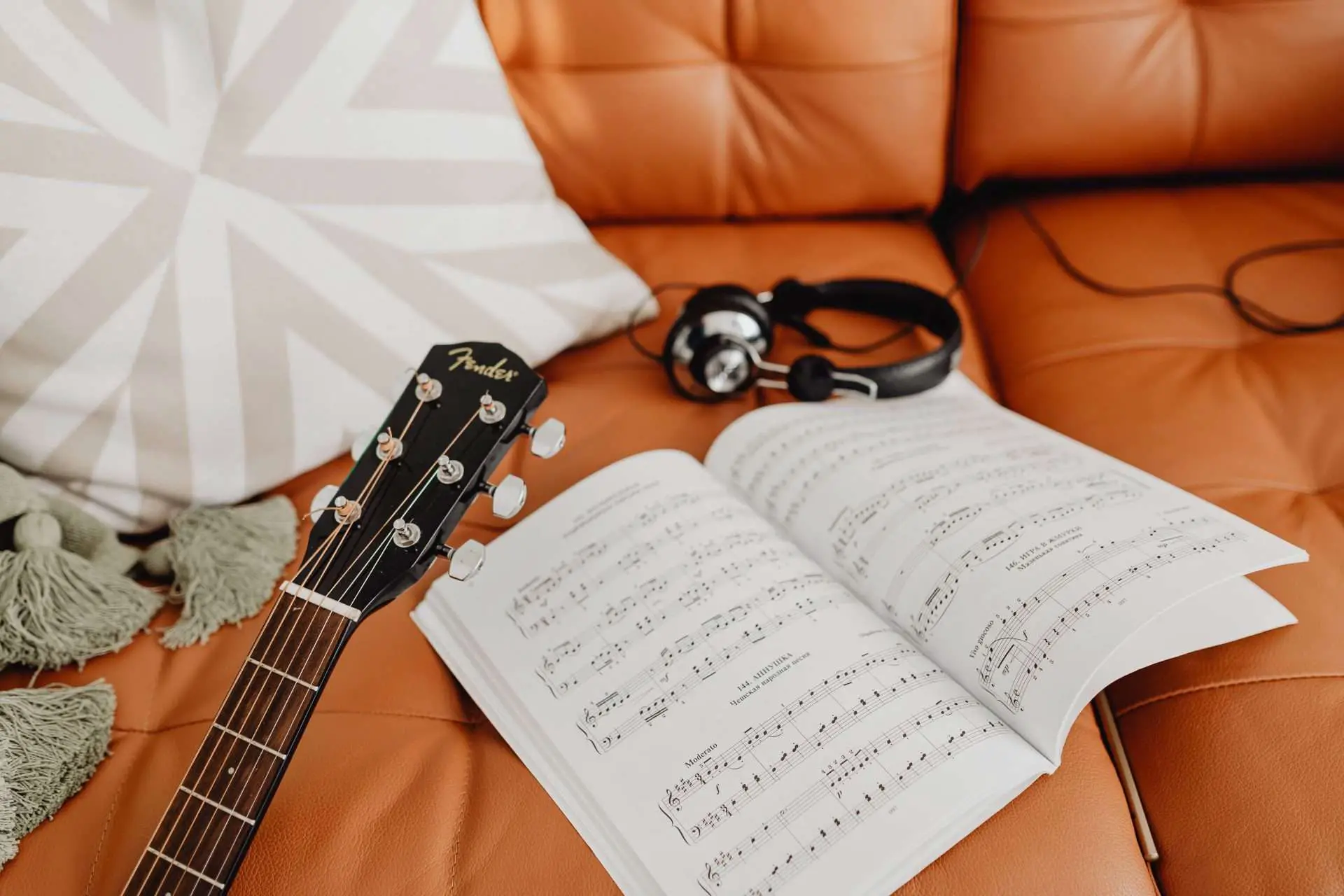
Related: How often should a beginner practice guitar
Frequently Asked Questions
What are scales vs chords?
Scales and chords are important musical elements that serve different functions.
A scale is a set of notes performed in a precise order that serves as the foundation for melodies and the tonal framework of a piece. It serves as a guide for musicians to navigate and generate musical ideas.
A chord, on the other hand, is a set of notes played at the same time to create harmony. Chords complement the melody and give songs their characteristic tone by serving as harmony building blocks.
While scales control melodies, chords give the harmonic framework, allowing the overall musical expression and effect to be shaped.
How many chords are in each scale?
From a major scale, a total of seven chords can be derived. These chords are formed by taking each note of the major scale and stacking additional notes in thirds above it.
In the major scale, the chords that can be derived are the I (tonic), ii (supertonic), iii (mediant), IV (subdominant), V (dominant), vi (submediant), and vii° (leading tone) chords. These chords provide a harmonic framework that can be used to create chord progressions and accompany melodies.
How long should I practice guitar each day?
When it comes to guitar practice, it is suggested that you aim for at least 30 minutes of focused practice per day. Progress requires consistency.
A regular daily practice routine is preferable to scattered hours of random playing. You can improve your skills more successfully by devoting concentrated time to specific exercises, techniques, or songs.
Quality practice sessions that focus on specific goals and difficulties produce better results than mindlessly strumming or playing for lengthy periods of time without direction. So, even if it’s only for 30 minutes a day, commit to a regular practice regimen and make the most of that time by remaining focused and intentional in your practice.
Related: How much guitar practice is too much
What chords are in the key of G?
In the key of G major, the primary chords that are commonly used are:
G major (G): This is the tonic chord and serves as the home base of the key.
C major (C): This is the subdominant chord and adds a sense of stability and balance.
D major (D): This is the dominant chord and creates tension that resolves back to the tonic chord.
Em (E minor): This is the relative minor chord and provides a softer, more introspective sound.
These chords, G, C, D, and Em, form the foundation of many songs in the key of G major and can be used to create chord progressions and accompany melodies.
Additionally, other chords such as Am (A minor), Bm (B minor), and F#dim (F# diminished) may be utilized to add variety and color to compositions in the key of G major.
Is there a pattern to guitar scales?
Yes, there is a pattern to guitar scales, including the major and minor scales. For the major scale, the pattern follows a specific sequence of whole steps (W) and half steps (H). The pattern for a major scale is W-W-H-W-W-W-H.
Similarly, the minor scale also has a pattern of whole steps and half steps. The natural minor scale pattern is W-H-W-W-H-W-W.
Understanding these patterns allows you to play scales in any key by applying the same interval structure on different starting notes. This knowledge helps you navigate the fretboard, improvise, and create melodies more easily.
How do guitarists remember all the notes?
As a guitarist, remembering all the notes on the guitar is achieved through practice and repetition. By regularly playing scales, chords, and songs, you gradually build familiarity with the fretboard and develop muscle memory. Over time, you’ll instinctively know where to find specific notes, allowing you to navigate the guitar confidently and play melodies and chords without hesitation.
One way to think of this is similar to how we learn language. First by learning all of the individual letters, then form words, phrases, and now we can read & write.
When it comes to “knowing” all the notes, we start by learning the individual notes, then entire measures, musical phrases, and finally entire songs.
Is 30 too old to learn guitar?
No, you are never too old to learn guitar! Age should never be a barrier to pursuing your passion for music. Whether you’re 30 or any other age, the guitar can bring joy, fulfillment, and creative expression to your life.
Embrace the journey, be patient with yourself, and enjoy the process of learning and playing. With dedication and practice, you can make remarkable progress and discover a whole new world of musical possibilities. So, go ahead and start your guitar journey with confidence and enthusiasm – you’ve got this!
Is it better to practice guitar in the morning or at night?
Some people find that practicing in the morning helps them start the day on a positive note, while others feel more focused and energized in the evening.
Our personal recommendation is to practice first thing in the morning. This way you can build a habit & focus wholeheartedly on your music. Who knows how the rest of the day will go, (hopefully good!) but if you’re having a bad day, at the very least you got some good guitar practice in & made progress.
Sure there’s challenges with playing guitar in the morning such as having to play at a lower volume and avoiding to wake others. But if you really want to level up your guitar skills, find a way around those & prioritize your music as first! And if you’re really focused, who says you can’t come back for seconds in the evening?

Conclusion
We discussed the fundamentals of scales in music theory in this blog, including their definition, components, and many varieties such as major, minor, pentatonic, and modes.
Now it’s time to put this information to use and investigate the practical applications of scales on the guitar.
Experiment with new scales, practice them on the fretboard, and follow your creative impulses to broaden your musical vocabulary, improve your improvisation skills, and pour depth and emotion into your guitar solos and compositions.
Scales are the cornerstone of music, providing a blueprint for guitar playing and allowing you to successfully express yourself.
Regardless of your ability level, learning scales and their applications on a regular basis will open up new possibilities and enrich your musical journey.
Embrace the power of scales, make them a regular part of your practice routine, and watch your guitar playing alter as you unleash your creativity and passion.
You now have the tools to take your guitar playing to new heights and open a world of musical creativity by using scales as your guide!
Related: Learning Guitar As An Adult
